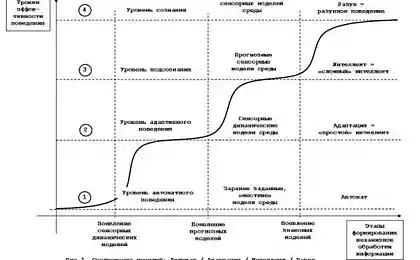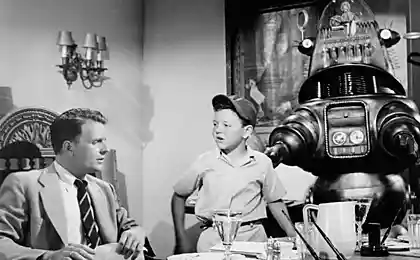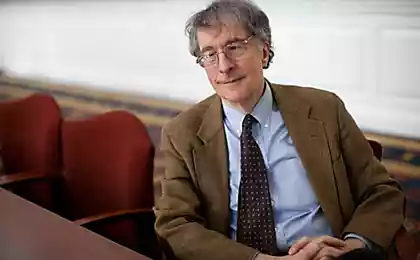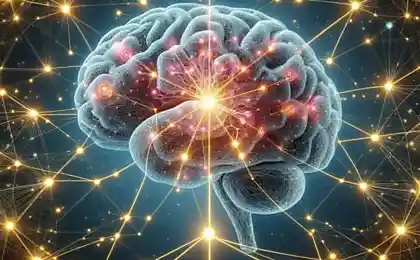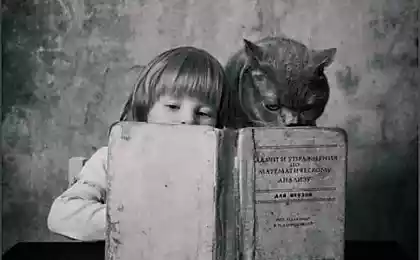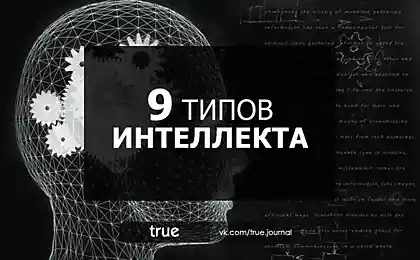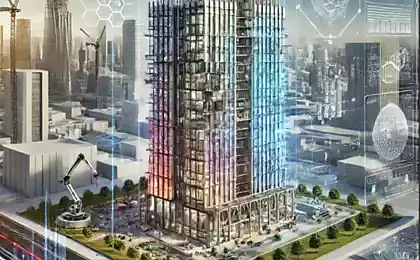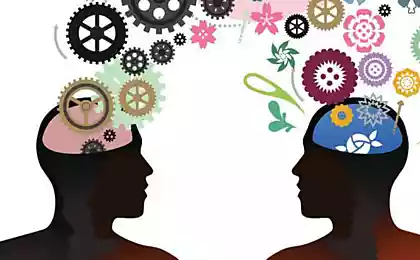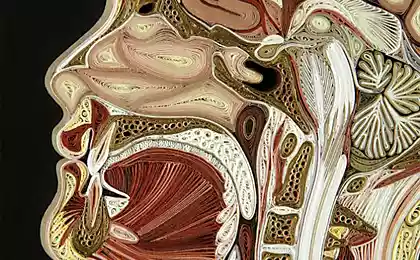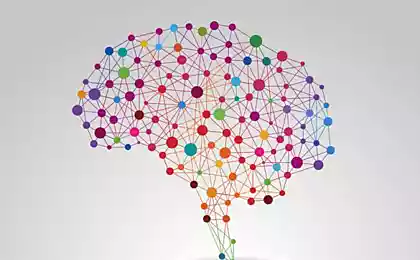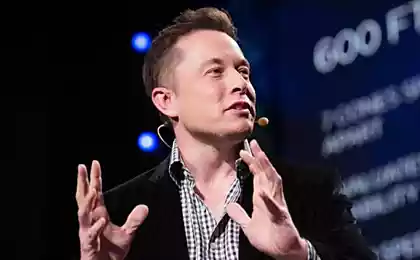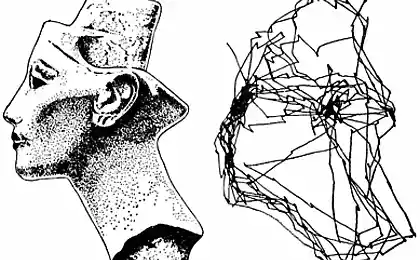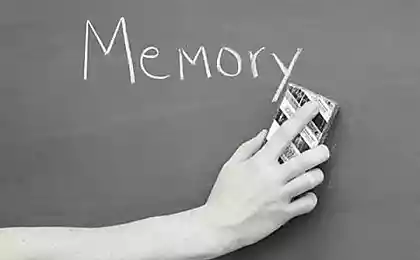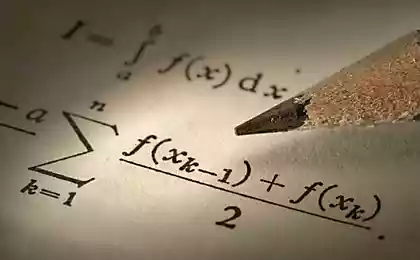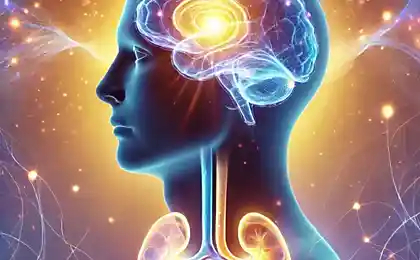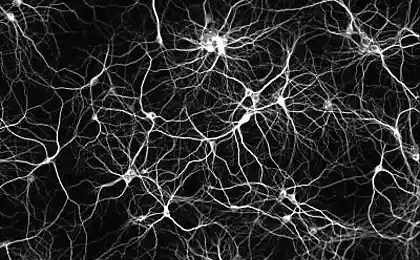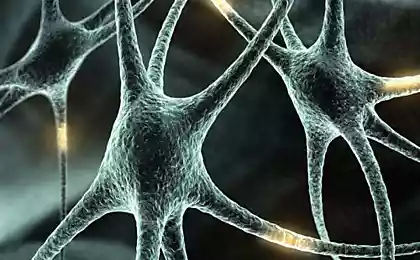3214
Logic thinking. Part 10: Spatial self-organization

This series of articles describes the wave model of the brain, is very different from traditional models. It is highly recommended for those who just joined, start reading from the first part of the .
We believe that the phenomena of the external world affect our senses, causing a certain flow of signals in nerve cells. During training bark acquires the ability to detect certain combinations of signals. Detectors are the neurons, synaptic weights are adjusted at the pictures of activity corresponding to the detected phenomena. Cortical neurons look after their local environment, forming their local receptive field. Information on the receptive fields of neurons comes either by the topographic projection or through the propagation of waves identifiers, bearing unique patterns corresponding to the already feature extraction. Neurons detectors responding to the same combination of features to form a pattern detector. Patterns of these patterns define unique identifiers waves that these patterns start coming into the state evoked activity.
In 1952, Alan Turing published a paper titled "Chemical basis of morphogenesis» (Turing AM, 1952), dedicated to the self-organization of matter. He formulated the basic principle was that the global order is determined by local interaction. That is, to get the structural organization of the whole system, not necessary to have a global plan, and can be limited exclusively to the task rules forming a close interaction between system elements.
Education neurons does not occur in isolation, but in view of the activity of their environment. Accounting rules that determine the activity of self-organization of the cortex. Self-organization means that the course of study is not just formed detecting neural patterns, and these patterns are arranged in a certain spatial structure having a definite meaning.
The most obvious way of self-organization - a structuring according to their proximity. Neurons can be trained so that the patterns corresponding to a close in a sense, concepts, proved in the space next to the bark. Later we will see that such an arrangement would be necessary to implement many important functions inherent in the brain. In the meantime, just look at the mechanisms that can provide an organization.
Rather ambiguous question - how to measure the closeness of concepts. One approach is based on the fact that any concept can be compared with some description. For example, the description of the event can be a vector whose components indicate the severity in the event of certain characteristics. Feature set, which is conducted description forms a descriptive basis. In this case, a reasonable measure of proximity - it's proximity descriptions. The closer description of the two phenomena, the more similar to each other, these phenomena. Depending on the task, which is then solved using the proximity measure, you can choose one or another calculation algorithm. Similarity measure is closely related to the notion of distance between objects. One can be counted in the other and vice versa.
A different approach - a temporary proximity effects. If two events occur simultaneously, but have different descriptions, it is still possible to speak about their specific proximity. The more often events occur together, the stronger should be construed their proximity.
In fact, these two approaches are not contradictory but complementary. If the two phenomena often occur together, it is necessary to infer the presence of the phenomenon, which is an implementation of this joint. This new phenomenon itself can be a sign that describes both the original phenomenon. Now, these phenomena appear in the general description, and therefore in proximity descriptive approach. Will be called intimacy, which takes into account both the narrative and temporal proximity, generalized proximity.
Imagine that you have to examine an object from different angles. Perhaps these types are quite different in descriptive terms, but nevertheless can not be denied their proximity in a different sense. Temporal proximity - a possible manifestation of this particular sense. Somewhat later we will develop much deeper this topic, now just note the need to consider both approaches in determining the proximity concepts.
The simplest for understanding the neural network, which is well illustrated by the degree of self-organization of the narrative proximity - a Kohonen self-organizing maps (see Figure below).
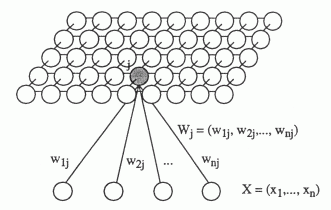
Suppose we have the input information given by the vector. There are two-dimensional lattice of neurons. Each neuron is connected to the input vector, this relationship is defined by a set of weights. Initially, the network will initiate random small weights. Feeding the input signal for each neuron can be determined by the level of activity as a linear combiner. Take a neuron that will show the greatest activity, and call it the neuron-winner. Next we shift its weight to the side of the image, to which he was like. Moreover, Do the same for all of its neighbors. Will weaken this shift as the distance from the neuron-winner.
here - the speed of learning, which decreases with time, - the amplitude of the topological neighborhood (n dependence suggests that it also decreases with time).
The amplitude of the neighborhood can be selected, for example, the Gaussian function:

where - the distance between the corrected neurons and neural-winner.

Gaussian function i>
As learning a self-organizing map will be allocated zones corresponding to how distributed training images. That is, the network itself will determine when the input stream to meet dissimilar pictures, and will give them a close representation on the map. At the same time, the stronger will be different images, the more apart from each other will be located and their representation. As a result, if properly paint the learning outcome, it will look something like this, as shown in the figure below.
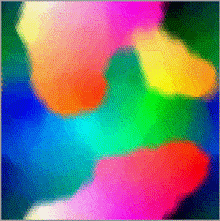
The result of training cards Cohanim i>
Maps Cohanim use function of the amplitude of the topological neighborhood, suggesting that neurons communicate through synapses in addition to exchange more information, talking about the nature of environmental activity, and this information can influence the course of their synaptic learning. The need to transfer more information occurred somewhat earlier and in our model. Describing training extrasynaptic receptors, we have introduced rules based on knowledge of neurons surrounding a certain type of activity. For example, the knowledge of the general level of activity allows us to make decisions as to the need for training, and the refusal of it.
To remain in the model within a particular biological validity, try to show what mechanisms in the real cortex may be responsible for the calculation and transmission of additional signals in axons unencoded information.
About 40 percent of brain volume occupied by glial cells. Their total number somewhere on the order exceeds the number of neurons. Traditionally, the glial cells rests mass service functions. They create surround frame, filling the space between neurons. Participate in maintaining homeostasis medium. In the development of the nervous system involved to form the topology of the brain. Schwann cells and oligodendrocytes, the major responsibility for myelination of axons that leads to multiple acceleration of nerve impulse transmission.
Since glial cells do not generate action potentials, they are not directly involved in an information interaction. But this does not mean that they are completely devoid of information functions. For example, plasma astrocytes located in the gray matter and have numerous highly branching processes. These processes surrounding synapses surround and affect their work (see Figure below).
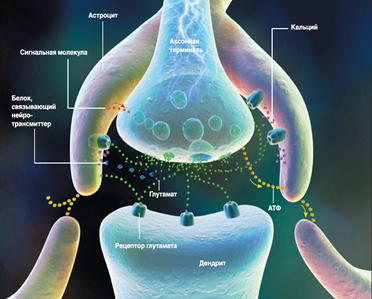
astrocyte and synapse (Fields, 2004) i>
For example, the following mechanism has been described (RD Fields, B. Stevens-Graham, 2002). Activation leads to neuron, axon that it is released from the molecules of ATP. ATP (adenosine triphosphate) - a nucleotide, which plays a crucial role in the whole body, its main function - ensuring energy processes. But other than that ATP can act as a signal substance. Under its influence is initiated movement of calcium into astrocytes. This in turn leads to that releases astrocyte own ATP. As a result, such a state is transferred to adjacent astrocytes, which transmit it further. Thus astrocytomas calcium absorption leads to the fact that it starts to affect the synapses, which is in contact with. Astrocytes are capable of both increasing reaction synapse due to the emissions of the mediator, and to weaken it by its absorption or release of the neurotransmitter binding proteins. Furthermore, astrocytes secrete signaling molecules capable of regulating the release of neurotransmitter axon. The concept of transmitting signals between neurons, astrocytes into account the effect called tripartite synapse.
Such interaction of astrocytes and neurons does not transmit specific information of images, but it is very well suited to the role of mechanisms to ensure "field of activity" that can manage learning synapses, and thus set the spatial coordinates for the new detector patterns.
In addition to astrocytes influence the behavior of synapses also intercellular matrix. Matrix - a set of molecules produced by cells of the brain and fills the intercellular space. The article (Dityatev A., Schachner M., Sonderegger P., 2010) shows that the change in the composition of the matrix affect the nature of synaptic plasticity, that is, to study neurons.
Impulse activity of neurons creates a spatial point pattern, which changes dynamically, encoding information flows. This activity changes the state of the environment and the glial environment matrix in such a way that creates something like a generalized field of activity (see Figure below).

Spot activity and field of activity i>
Field of activity on the one hand, a point blurs activity, creating an area extending beyond the active neuron on the other hand, has been and continues to inertia for a while after the termination of the pulse activity.
If within this field of activity, we will create the image of the detector current supply, it would be close to the detectors similar to it. In this case, the similarity may be as similarity to the receptive field and similarity arising due to combination of events in time.
In the real brain is best studied the spatial organization of the zone of the primary visual cortex. Due to the transformation begins in the retina, the primary cortex receives a signal in which the basic information - a line describing the contours of objects in the original image. Neurons in the primary visual cortex sees mostly small fragments of lines passing through their receptive fields. It is not surprising that a significant portion of neurons in this area - it detectors lines coming from different angles.
Experimentally found that the neurons are arranged vertically one above the other, respond to the same stimulus. A group of neurons called cortical mini column. Vernon Mountcastle (V. Mauntkasl, J. Edelman, 1981) hypothesized that the brain cortical column - this is the basic structural unit of information processing.
We previously talking about patterns of neural detectors, portrayed them in groups of neurons distributed in a certain local area. This was due to the fact that in the simulation, and accordingly, the use of flat images of preparing neural network. The real three-dimensional crust. The bulk of the cortex does not affect our discussion of the origin and propagation of waves identifiers. In the three-dimensional waves propagate crust just like in a plane. But the bulk crust, nothing prevents us to arrange neurons detectors, forming a single pattern, vertically one above the other. This arrangement no worse and no better than any other. The main requirement for the pattern - it's an accident pattern. Since communication neurons randomly distributed, then placed vertically in one column of the cortical neurons can be considered a random pattern. This vertical location is quite convenient in determining the place of incorporation of the detection pattern. It is not necessary to determine the local area, but rather indicate the position in which you want to create a pattern. Positioning can be, for example, where the maximum field of activity for all the free speakers certain neighborhood. We can assume that cortical minicolumn real crust - this is the pattern detector, described in our model.
Traditional models of the cortex, not taking into account the wave signals an explanation of what all neurons minicolumn respond to the same stimulus is certain difficulty. We have to assume that it is either duplicated for fault tolerance, or attempt to collect together the neurons that respond to a stimulus, but tuned to its definition in different positions common receptive field. Latest headlines in neocognitron planes through the use of simple cells. Wave model allows us to look at it from a different angle. It can be assumed that the problem of cortical mini speakers - is to learn the characteristic stimulus, run the appropriate wave identifier. Then, several tens of neurons forming a mini column and reacting together - this is the mechanism for running wave, i.e., the detection pattern.
Organization of orientation columns in the visual cortex of real forms so-called "tops» («pinwheel»). This "top" (shown below (B)) has a center where different orientations converge column, and diverging tails, which are characterized by a smooth change of the preferred stimulus. One top form hypercolumns. Tails different hypercolumns into each other, forming an orientation map of the cortex (Figure below (A)).
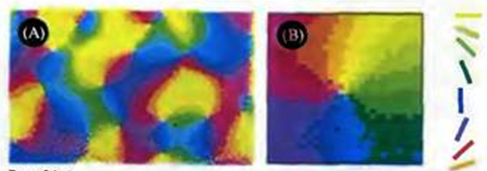
The distribution of orientation columns in a real crust obtained using an optical method (J. Nicholls., Martin R., Wallace B., P. Fuchs, 2003) i>
On the example of the visual cortex is convenient to compare the actual distribution of orientation columns and simulation results with field activity.
We will apply for a fragment of bark lines at different angles. Neuronal activity detectors will be assumed as the cosine of the angle between the flow way and manner on the detector.
Neuron index has coordinates on the bark. The value of the field of activity of the neuron at coordinates can be represented, for example, through a Gaussian distribution:

At each point of the cortex final value of the field of activity can be written:

Will be posting new detectors in a free position, for which the maximum value. The result of this training is shown in the figure below.
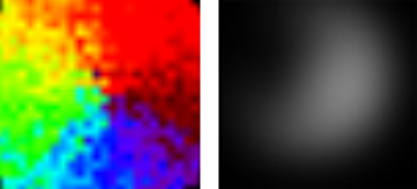
The result of training detectors (left), the field of activity (right) i>
As can be seen, the simulation result is very similar to the real distribution. But it should be noted that this example is very conventional. In real crust, each column shifted with respect to several neighbors and watching a slightly different image fragments. This creates the "tails" of the detectors tuned to the same orientation. But at the same incentives such detectors - two different images based on different receptive fields.
Spatial self-organization of the cortex can be compared to the self-organization of matter in the world around us. Atoms, molecules, objects, planets, stars, galaxies, and the universe - all this is a consequence of the existence of four fundamental interactions. To talk about gravitational, electromagnetic, strong and weak interactions. Particles of matter create around themselves fields corresponding interactions. The same type and form fields are added together resulting field. The resulting field influence particle determining their behavior. Somewhere in the same situation with the brain. It seems that the crust can create several types of fields, with different properties. Each field has its effect on the behavior of neurons. The totality of these interactions, for example, a learning algorithm may determine the synapses and thereby the spatial organization of neurons detectors.
It is easy to notice that the spatial grouping by proximity generalized contains an internal contradiction. In this regard, recall the anecdote. Decided to somehow divide the animals lion on a beautiful and intelligent. So worth confused monkey, "And I now break?". Difficulties arise when the concept is to be placed close to other, remote from each other concepts.
References
Previous parts:
Part 1. Neuron
Part 2. Factors
Part 3: Perceptron, convolutional network
Part 4. Background activity
Part 5. The brain waves
Part 6. System projections
Part 7: Human-Computer Interface
Part 8: Allocation of factors in the wave networks
Part 9 patterns of neural detectors. Rear projection
Alex Redozubov (2014)
Logic thinking. Part 9. The pattern of neural detectors. Rear projection
The logic of thinking. Part 11: Dynamic Neural Networks. Associativity
